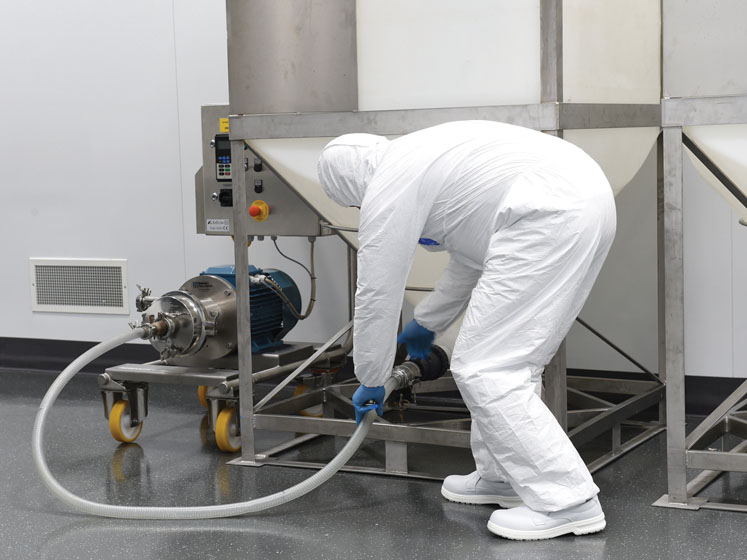Many large-scale raw material suppliers are not set up to deliver niche customisation requests; instead, their business model requires the production of standard products at scale to be profitable.
Against this backdrop, responsive and flexible raw material suppliers are of immense value to many developers in the industry. They can accommodate additional GMP manufacturing steps while also reducing impurity levels and providing the necessary support as customers journey from R&D to clinical and commercial phases. We see this trend continuing to grow.
Buffer outsourcing
Buffers, the compounds or mixtures used to control pH during drug production, play a vital stability maintaining role in both small molecule and biologic drugs. Today, with rising interest in cell and gene therapies (CGTs) for diseases ranging from cancer to inherited conditions — and the growing need to manufacture vaccines — biopharmaceutical companies are increasingly looking to outsource the development and production of buffers for both their drug development programmes and therapeutics.
Whether constrained by physical space, requirements for higher concentrates, a lack of resources or a preference for lean operations, the economics of make versus buy when it comes to buffers is leaning towards buy!
Growth in CGTs, as well as changes in the small molecule market, have made the production and use of buffers more specialised and more challenging. As a result, large and small biopharmaceutical companies alike are increasingly relying on third-parties to source their buffers.
Leveraging expertise
Buffers are an important element in the production of therapeutics; but, keeping production in-house comes with associated capital and labour costs. These tasks are often better managed by a trusted outsourcing partner that’s capable of producing GMP-grade buffers to meet both upstream and downstream needs.
Although buffer production may seem like a straightforward process, it is increasingly one best managed by experts in this specialised field. As production techniques shift and new therapeutic classes such as CGTs become more common, having a trusted partner to guide the development and testing of all the buffers needed for each unique drug formulation can result in a more efficient manufacturing process.

During the past few years, for example, many biopharmaceutical companies have been producing higher titre therapeutics, which can create potential downstream purification problems and require more buffers. This increasing volume demand can create an in-house bottleneck, which is easily solved by using an outsourcing partner.
Further, CGTs are an even greater challenge, often requiring 25–30 different buffers in a single process. For companies whose focus is on developing high-value protein-based drugs, turning their attention to the production of an optimised set of different buffer solutions is far from their core expertise and very likely to be a diversion from their company’s mission.
An experienced outsourcing partner can help to ensure that not only does a biopharma partner get the development expertise they need in terms of buffer combinations and formulations, they can also rely on getting just-in-time GMP-grade buffers with all the validation and documentation required for downstream production.
Maximising capital, minimising facility footprints
A key consideration for many companies when deciding to outsource buffer production is the physical space required for the mixing tanks and storage (of both the raw materials and finished buffers before use). For many biopharma companies, especially start-ups, facility floorspace is at a premium and better devoted to lab space or other core functions.
Depending on the number of buffers needed and their warehousing requirements, keeping buffer production in-house can easily add 20% or more to a company’s physical footprint. In-house buffer production can also be a bottleneck.
Producing 1000 kg of bulk drug substance per year requires 1.5 million litres of buffer for purification, which slows production. In addition, devoting staff to manage the logistics of raw material sourcing and co-ordinating the production of a broad array of buffers is complex and requires capital to keep all these materials in stock.
A custom buffer supplier can work with a biopharma’s internal production team to understand their production schedules, determine buffer consumption levels and manage just-in-time deliveries of the needed supplies, which reduces both storage space and preserves capital.
Outsourcing for CGTs
Research by McKinsey & Company in 2020 reported the increasing clinical and preclinical development activities of CGTs, but also noted that development in this area by the largest 20 biopharma companies was slow and measured. Only 15% of approved CGTs were launched by these companies.
The upstream numbers were even lower, with only 13% of clinical programmes and 4% of preclinical CGT assets being held by Big Pharma. The reason for this is simple, the report stated: large biopharma companies tend to focus on developing therapies in specific disease areas such as cancer and not on developing the new technology platforms needed to create novel CGTs.
Most technology platform work is done in academic settings and, once proven, is spun out as small biotech start-ups. By their very nature, these venture-fund-backed companies need to operate leaner with a laser focus on continuing to optimise their technology or potential drug candidates. Outsourcing non-core activities is, therefore, commonplace.

Based on the instability of living cells, there are unique challenges related to the production of CGTs. This requires manufacturing to occur before the living cells expire and, as living cells can’t be sterilised (or sterile filtered), processing must occur in an aseptic environment. In addition, the proteins in gene therapies tend to be sticky; material segregation and frequent cleaning is essential to prevent cross-contamination.
For these therapies, the need for GMP-grade buffers is critical. Those in the upstream process need to maintain a very tight pH window for the culture material to preserve the active characteristics of the therapy. In these instances, the use of buffers such as TRIS, MES and guanidine hydrochloride help to ensure the efficacy of upstream processes while also complying with global regulatory requirements.
Downstream buffers need to accommodate the very specific conditions under which CGTs will remain stable. In these instances, GMP-grade buffers including phosphate, citrate and acetate that can maintain predefined purification conditions, provide stability for the therapeutic biologics and protect them from coprecipitants.
Although the development of CGTs is a new and highly specialised field, so too is the understanding and expertise required to optimise the buffers needed to shepherd these products to approval. Working with an experienced custom buffer supplier can help to protect and optimise the assets of CGT start-ups to give them the best chance of clinical success.
Choosing the right supplier
A secure supply chain and the partner company’s ability to maintain a steady on-time/in-full stream of the needed buffers is paramount. In addition, it’s essential to discern the organisation’s warehousing capabilities for the required buffers and whether they meet all the quality requirements and provide the documentation needed for the project.
A facility visit is a good way to see how a buffer manufacturer/supply company operates, the quality systems it has in place and its ability to serve each client’s specific needs. Equally important is introducing the project teams of both companies to each other to allow for a better understanding of how each party works, outline the project requirements and share information that improves the design of any custom buffers.
At Actylis, we have purpose-built GMP liquid manufacturing facilities in Europe and North America to produce upstream and downstream liquids with water-for-injection (WFI).
All materials can be customised to meet specific requirements and are backed by supporting documentation, in-house expertise and a dedicated team to ensure a successful partnership. Actylis also has a number of other manufacturing sites in North America and Asia that produce excipients and critical raw materials as well as APIs and process intermediates.
